Wondering what clients look for in a writer’s portfolio?
Freelance writing is competitive, and without a strong portfolio, getting paid to write can feel impossible.
But the good news is, you don’t need client work to create a portfolio that gets you hired.
I started freelance writing completely from scratch. And I struggled to understand why potential clients expected me to have a writing portfolio when I hadn’t worked with anyone yet.
I wanted them to hire me so I could show them I can write!
If you’re in the same boat, don’t worry. This guide is for you.
I’ll walk you through simple, actionable steps to build a writing portfolio as a beginner.
What is a Writing Portfolio and Why Do You Need One?
A writing portfolio is a collection of your best writing samples that demonstrate your skills.
But why is your resume not enough?
Why can’t clients just take your word for it when you say you’re “a hardworking writer who can create compelling content that drives traffic?”
Same way you wouldn’t spend your hard-earned money on a product you’ve never seen or heard anyone vouch for (except the person selling it).
Clients need proof that you can write well and that their content (and brand) will be in safe hands.
That’s why you need quality writing portfolio samples- to give potential clients the confidence to hire you.
A strong portfolio builds credibility and trust. It shows clients exactly what you bring to the table.
What Should You Include in Your Writing Portfolio?
As you build a writing portfolio, you need to include:
- A short writer bio that tells clients who you are and what you do.
Talk a little bit about the type of writing you’ve done and in which industry (eg I’ve published blog posts in the entrepreneurship niche)
- Your best writing samples tailored to the type of writing you want to do and the clients you want to attract.
For example, if you want to write email marketing copy for solopreneurs, create mock emails for a fictitious or real brand and include them.
Demonstrate exactly what you can do.
And make it visually appealing by adding eye-catching images to go with your samples.
- If you have testimonials or reviews, even from friends, mentors, or beta clients, include them. Social proof goes a long way in building trust.
- Finally, make it easy for potential clients to reach you by adding your contact information:
- Your email address
- Phone number, and
- Links to your social profiles.
The goal is to remove any friction between them reading your work and hiring you.

The Writing Process: How to Create Portfolio Samples from Scratch
By now, you’ve probably done a lot of research or taken courses on how to write for social media, blogs, or emails, depending on your interests.
Now, it’s time to put that knowledge into action and create your first writing portfolio samples.
Research your ideal client to Build a Writing Portfolio
Before you start writing, take time to understand the type of clients you want to work with.
Is it startups, SMBs (Small and Medium Business), or solopreneurs?
What are their characteristics and how do they operate?
What do they struggle with the most when it comes to content marketing?
You can’t randomly create sample pieces, or any content for that matter, without your ideal audience in mind.
The better you understand them, the more relevant and valuable your writing samples will be.
- Follow them on social media and engage with their content. Pay attention to the topics they discuss.
- Look at the content they publish on their websites and compare it with what similar businesses are doing. Spot the gaps you can fill and the trends that stand out.
- Understand their target audience. Who are they trying to reach and why?
This will help you build a writing portfolio that gets you hired even with no experience.
What to write about
For the sake of clarity, because I really needed practical examples when I was starting my freelance writing journey,
Let’s say you want to land clients in the entrepreneurship niche as a content writer.
As you build a writing portfolio, your writing samples need to reflect the kind of content your ideal clients would need.
You could write articles about:
- “How to Start an Online Business Without Wasting Resources (Time and Money)”- A practical guide that positions you as someone who understands entrepreneurs’ pain points.
- “50 African Entrepreneurs You Should Follow in 2025,” – A listicle that demonstrates your research skills and ability to create engaging content.
- “The Role of Content in Scaling Your Brick and Mortar Business.”- A strategic piece that shows you can educate business owners on content marketing.
Writing about topics your ideal clients care about proves you understand their industry and challenges.
Find Relevant keywords using Google Keyword Planner
To build a writing portfolio that’s strong and improve your chances of getting hired, you need to incorporate some relevant keywords in your content.
Use free keyword research tools like Google Keyword Planner to discover relevant keywords.
It’ll help you have an SEO-optimized writing portfolio.

Incorporate the keywords with low competition and high search volume throughout your content- your headline, introduction, subheads, the body of your text, and your conclusion.
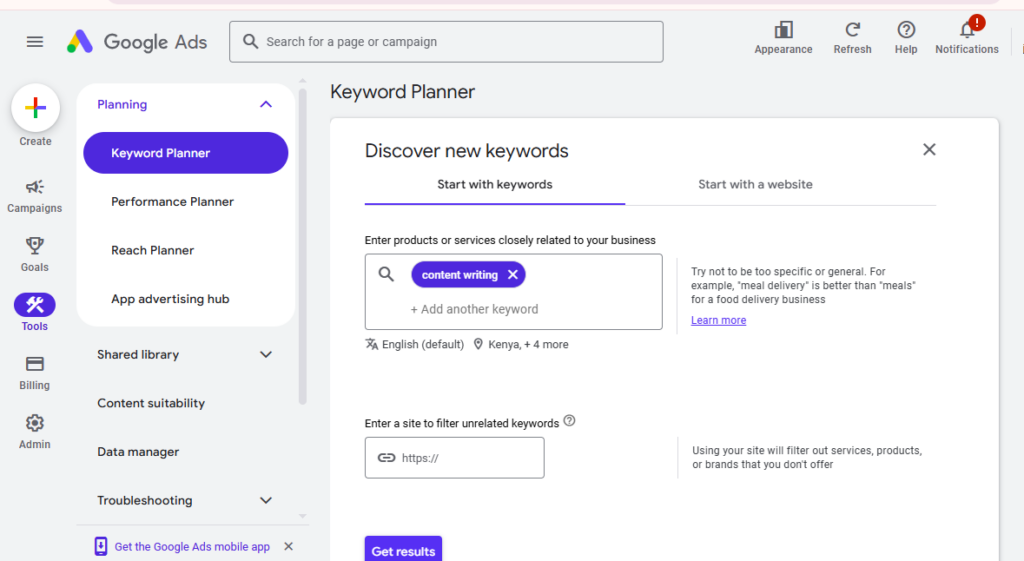
In this case, I searched for the keywords “content writing” as you can see in the first text box.
Then I added the locations I want to target using the location icon at the bottom of the first text box.
You can leave the second text box blank and go ahead and click on “Get results.”
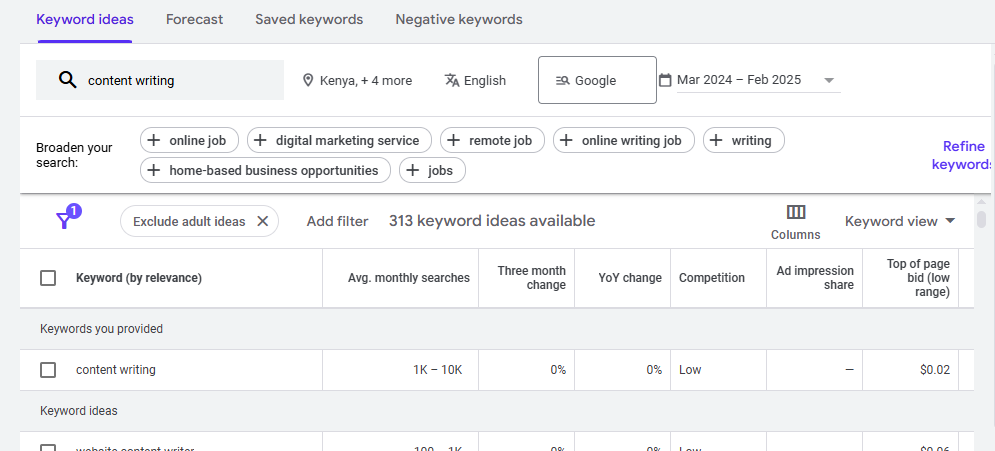
The results you get here are for Google searches happening in the locations you specified.
Here, you want to go with keywords that have about 10K average monthly searches and “low” competition to increase your chances of ranking for them.
Use power words in your headline
Your headline is the first thing a potential client sees, so it needs to be engaging.
Power words evoke emotion, curiosity, and urgency. They make your headlines more engaging.
Here are some examples of power words you can use:
- Proven: “The Proven Formula to Writing Blog Posts That Attract Clients”
- Ultimate: “The Ultimate Guide to Building a Writing Portfolio From Scratch”
- Secrets: “Freelance Writers’ Best-Kept Secrets to Landing High-Paying Clients”
To check if your headline idea is good enough to drive engagement, use CoSchedule’s Headline Studio.
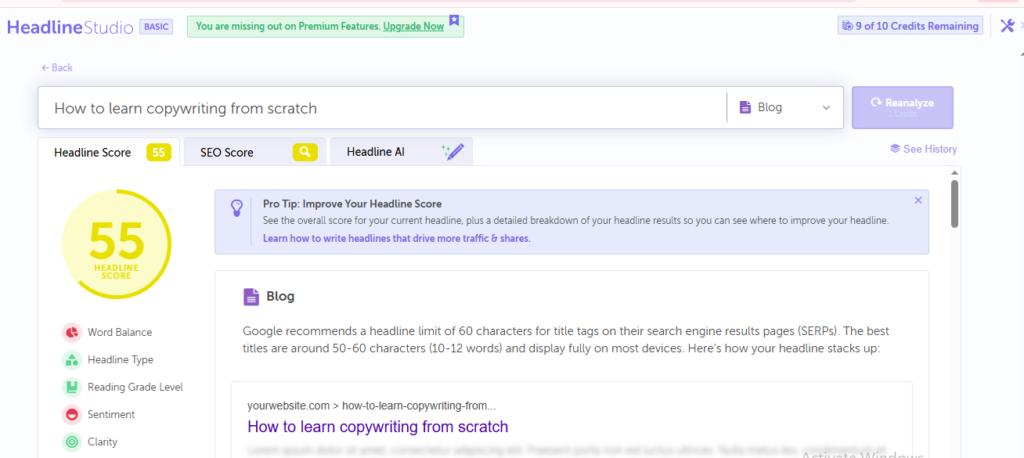
You type in your headline and it gives you suggestions to improve.
On the free plan, you get 10 headline analysis credits per month. Each time you analyze a headline you’re one credit down.
So come up with your best headline idea and make sure you’ve selected the right content type (blog, YouTube, email, podcast, LinkedIn, etc) before hitting “analyze.”
Structure your content for readability
A well-structured piece keeps readers engaged and makes your writing easier to skim.
- Use short paragraphs to avoid overwhelming the reader.
- Break up sections with subheadings to improve flow.
- Use bold text to emphasize key points.
- Keep sentences concise and use bullet points to improve readability.
- Add relevant images to support your content, and don’t forget to include alt text for SEO and accessibility.
Always put yourself in the reader’s shoes and write content that’s clear, engaging, and easy to navigate.
Use writing tools to write with confidence
It’s easier to write content as you build a writing portfolio when you have the right tools to help you polish it up.
Some tools I’ve used are:
- Grammarly to catch typos, grammar mistakes, and awkward phrasing.
- Word counter to check the length of my articles. Comprehensive guides can be as long as 2000+ words while other topics can easily be covered in 800-1500 words.
- Hemmingway editor to simplify my writing for better readability. It highlights long, complex sentences to help you make your content clearer and more concise.
- ChatGPT to brainstorm ideas and structure my content. You can also use it to create blog outlines and speed up your writing process.
Where to Host Your Freelance Writing Portfolio
You want potential clients to find your work easily and see it in a professional format.
Here are your best options:
Option 1: Free Platforms
When you’re just starting out, free platforms are a great way to showcase your work without spending a cent.
Medium is a user-friendly blogging platform where you can publish your writing and build an audience.
LinkedIn Articles are perfect for positioning yourself as an expert while networking with potential clients and fellow writers.
I don’t recommend keeping your writing samples in Google Docs alone. Yes, it may seem convenient but published work looks far more professional.
Plus, when your content is live on a platform, potential clients can see engagement (likes, comments, and shares), which adds social proof to your expertise.
Option 2: Your Own Website
A self-hosted website is the most professional way to host your portfolio.
It elevates your personal brand as a writer.
Having your own site also lets you practice different types of writing: Homepage copy, service pages, about pages, blogs, and portfolio pages.
You don’t need to wait for a client to learn these skills. You can learn as you go while establishing your online presence.
If you’re trying to keep costs low (as most of us are!), consider free and budget-friendly website builders like:
- The free version of WordPress
- Wix
- Carrd (great for simple one-page portfolios)
- Journo (built specifically for journalists and writers)
- Canva (yes, Canva has great website templates too!)
The main thing to focus on as you build a writing portfolio is ensuring it’s easy to access, well-organized, and visually appealing.

How to Use Your Portfolio to Land Paid Writing Gigs
Now that your colorful writing portfolio is ready, it’s time to start sharing it.
- Include your portfolio link in Upwork proposals, job applications, and cold pitches. Make it easy for potential clients to see your work.
- Add your portfolio link to your LinkedIn featured section with a call to action that says “work with me” or “hire me.” Make your portfolio absolutely impossible to miss.
- Use your business social media profiles to talk about your services and increase your touchpoints with potential clients.
- Network strategically with fellow freelance writers and decision-makers in businesses you want to work with. Think CMOs, content strategists, and marketing directors. Find them on LinkedIn and start engaging with their content.
When approaching clients, highlight how your samples prove your ability to deliver results.
Personalize each client interaction (be it a pitch, Upwork proposal, or job application) and show how your writing aligns with their needs.
5 Great Freelance Writing Portfolio Examples From African Writers
I thought I’d include some live portfolio examples to inspire you and show you that it doesn’t have to be complicated.
Check these out and look at how they’ve presented their work.
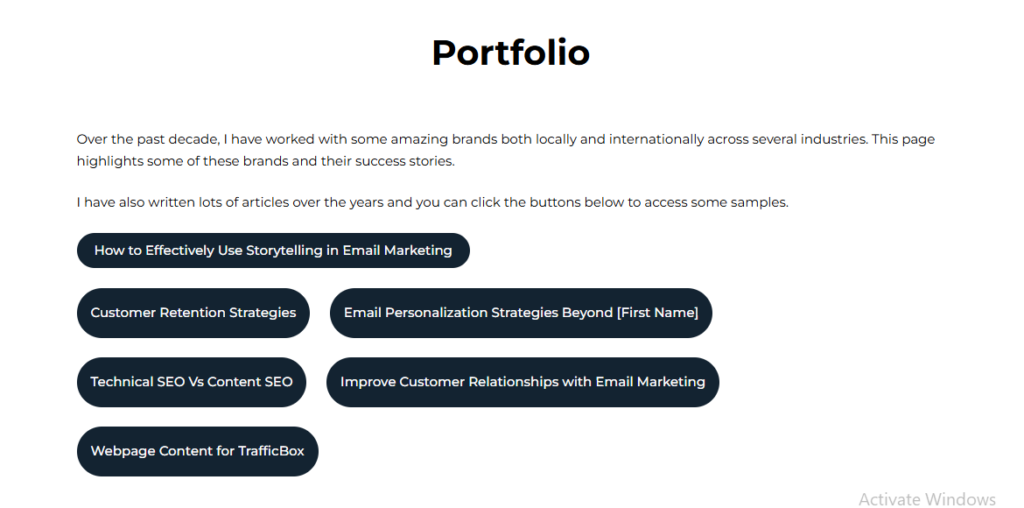

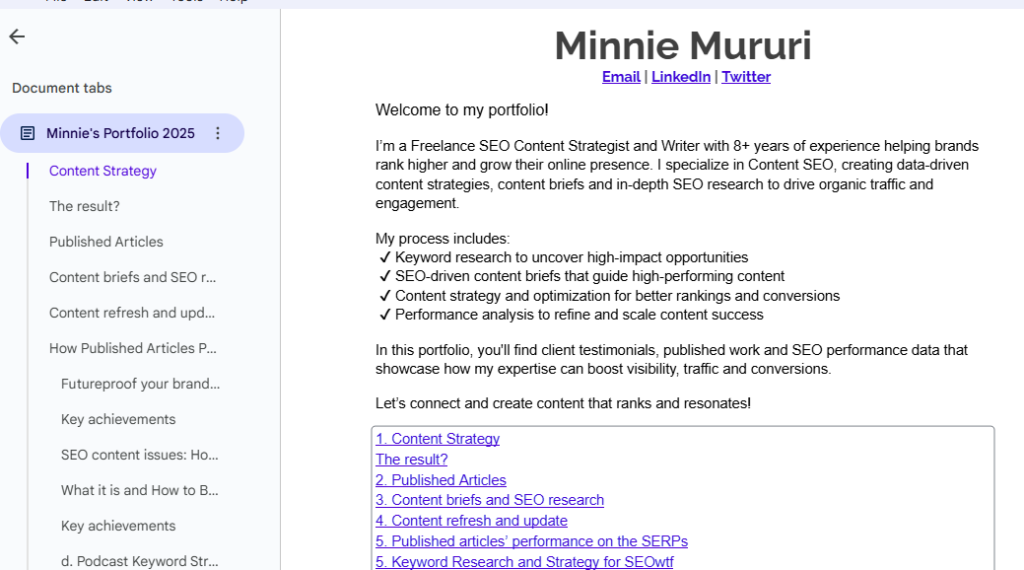
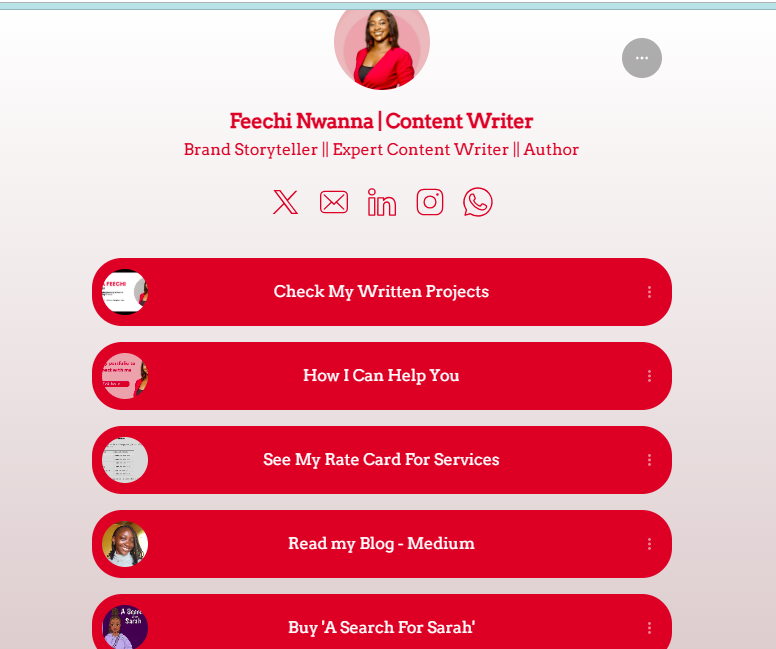
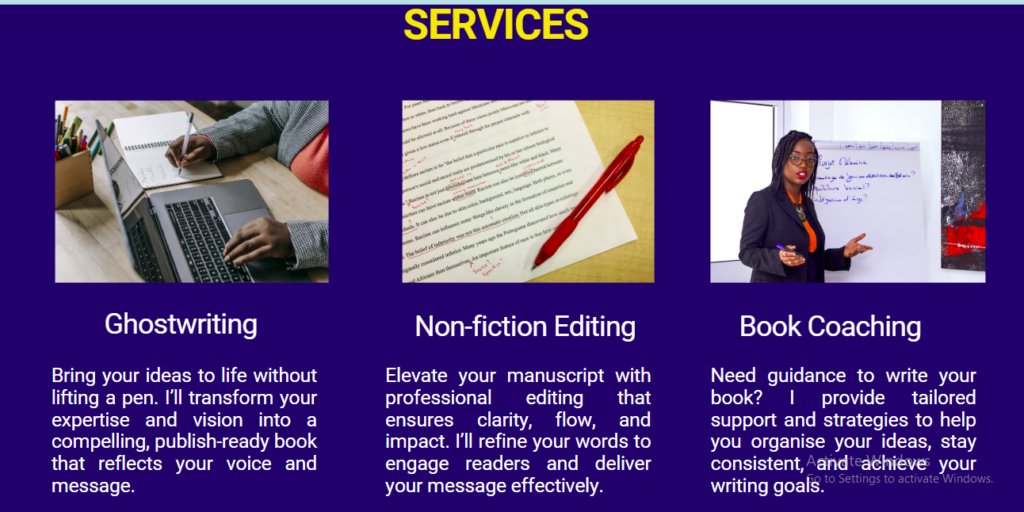
Have you started writing your portfolio pieces yet? I’d love to know how it’s going for you in the comments!




One Response